Design Arch Opened 1 July 1839 | Heritage status Grade I listed Construction started 1835 Material Brick | |
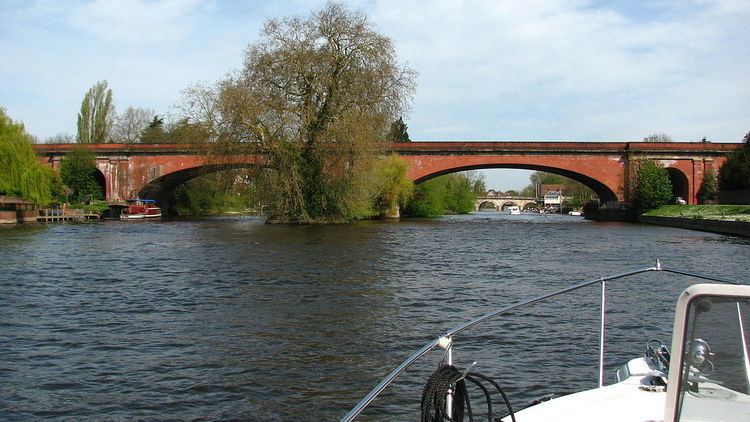 | ||
Height 32 feet 2 inches (9.80 m) Similar River Thames, Maidenhead Bridge, Box Tunnel, Windsor Railway Bridge, Boulter's Lock | ||
61305 mayflower crossing maidenhead railway bridge
Maidenhead Railway Bridge (aka Maidenhead Viaduct, The Sounding Arch) is a railway bridge carrying the main line of the Great Western Railway over the River Thames between Maidenhead, Berkshire and Taplow, Buckinghamshire, England. It crosses the Thames on the reach between Bray Lock and Boulter's Lock at the downstream end of Guards Club Island.
Contents
- 61305 mayflower crossing maidenhead railway bridge
- Maidenhead railway bridge boats and trains
- History
- Bridge widening
- Crossrail Modifications
- References
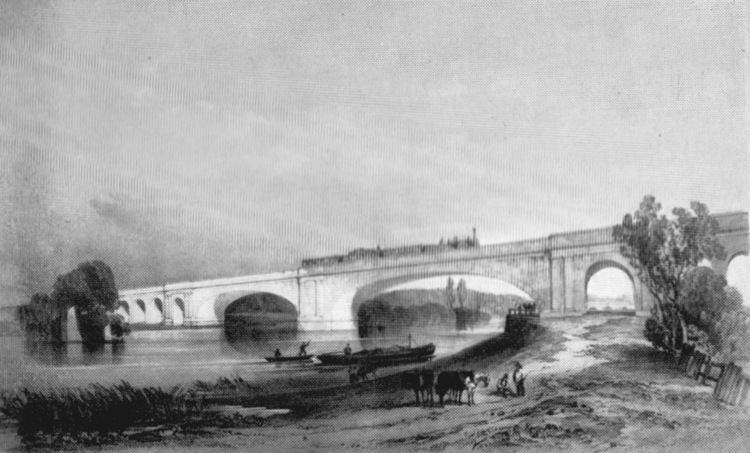
Maidenhead Railway Bridge features in Rain, Steam and Speed – The Great Western Railway, painted by Turner in 1844 and now in the National Gallery, London
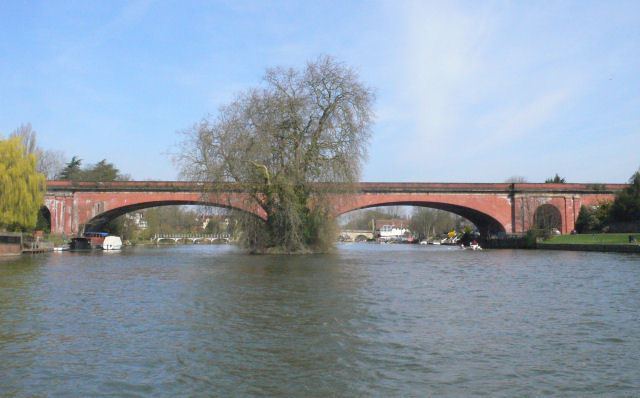
Maidenhead railway bridge boats and trains
History
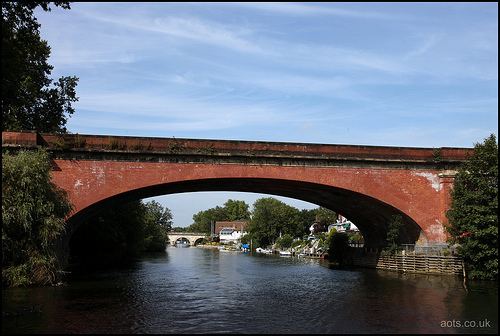
The bridge was designed by the Great Western's engineer, Isambard Kingdom Brunel, and it was completed in 1838, but not brought into use until 1 July 1839. Brunel's first plan envisaged a triple-arch viaduct, but he then developed the design that is still used today. It was inspired by experiments made by his father, Marc Brunel in 1832 which Isambard had at the time financed. The railway is carried across the river on two elliptical brick arches, which at the time of building were the widest and flattest in the world. Each span is 128 feet (39 m), with a rise of only 24 feet (7 m). The flatness of the arches was necessary to avoid putting a "hump" in the bridge, which would have gone against Brunel's obsession with flat, gentle gradients (1 in 1,320 on this stretch). The Thames towpath passes under the right-hand arch (facing upstream), which is also known as the Sounding Arch, because of its spectacular echo.

It has been claimed that the board of the Great Western Railway did not believe that the arches would stay up under the weight of the trains and ordered Brunel to leave the wooden formwork used to construct the arches in place. However, Brunel simply lowered the formwork slightly so that it had no structural effect, but appeared to be in place. Later, when the formwork was washed away in floods, but the bridge remained, the strength of the arches was accepted.
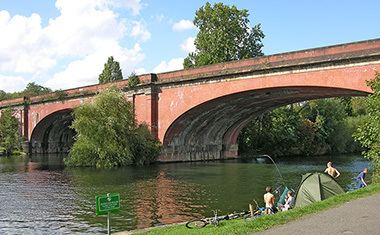
As built, Maidenhead Railway Bridge carried two lines of Brunel's broad gauge track. Subsequently the bridge was widened, and now carries the four lines of standard gauge track that make up the Great Western Main Line out of London Paddington Station.
Bridge widening
As built and opened on 1 July 1839, the bridge carried two 7 ft (2,134 mm) railway tracks. In due course traffic to and from London increased enormously, and mixed gauge tracks were provided between London and Bristol during 1861. In anticipation of the final conversion to the standard rail gauge, during 1890–1892 the bridge was widened on each side to carry four standard gauge tracks. This work was carried out under the supervision of Sir John Fowler, the width overall being increased from 30 feet (9.1 m) to 57 feet 3 inches (17.45 m). However, this was undertaken so sympathetically that the outward appearance of the bridge remained almost unaltered.
In July 2012, the Maidenhead Railway Bridge was upgraded to Grade I listed status by the Department for Culture, Media and Sport following a consultation with English Heritage.
Crossrail Modifications
The forthcoming Crossrail development will see the long-delayed overhead electrification of the Great Western line between Paddington and Maidenhead or Reading. This construction work had been set to require a temporary construction depot to be created immediately next to the bridge in Guards Club Park on the Berkshire side of the bridge, but this decision has subsequently been reversed, though the bridge itself will obviously still undergo some changes to accommodate the Overhead line equipment. The latest Crossrail Environmental Statement states:
"The OHLE (Overhead Line Equipment) requires that supporting posts be founded on the bridge structure. These will be positioned so as not to disrupt the symmetry of the bridge. Three sets of masts will be fixed at the bridge supports and a further two sets will be fixed at the far ends of the bridge. The masts will be fixed such that they may be removed in the future without damaging the bridge as it stands today."
The report also states:
"It is proposed that the OHLE over Maidenhead railway bridge will use masts with wires suspended from cantilevers, since these will be visually lighter structures than the gantries to be used along other parts of the route. The masts will however, have a significant adverse landscape impact: they will affect important views along the river and the character of the river corridor; they will affect the setting of the Riverside Conservation Area; and they will affect the setting of the listed railway bridge and the setting of the adjacent Grade I listed road bridge."
The possibility of using third rail electrification on the bridge was considered but rejected.
